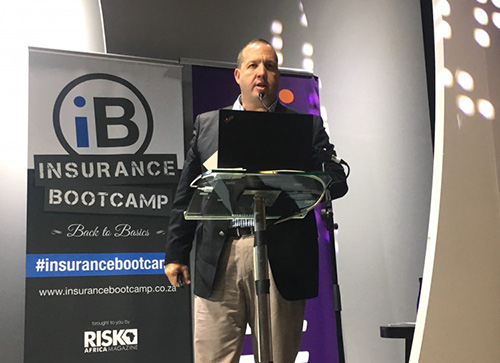
Insurance Bootcamp facilitator Tim Timmerman (right) introduces panellists Nick Evans (Global Choices), Grant Carstensen (Hollard Broker Markets), Letlhogonolo Tau (Sasria) and Wimpie van der Merwe (Global Choices).
This was the message of Grant Carstensen, head of Hollard Broker Markets’ Trucking Centre of Excellence, to the audience for the first Insurance Bootcamp of 2017. The theme for this Bootcamp is “Motor: trucking, HCV, goods in transit, personal lines and VAPS”.
The Insurance Bootcamp is an initiative of RISKAFRICA magazine, the Financial Intermediaries Association (FIA) and the Insurance Institute of the Cape of Good Hope. It is supported by the Insurance Institute of SA, and Hollard is its diamond sponsor.
Speaking in Johannesburg this morning, Carstensen – who interspersed his presentation with startling videos of trucking accidents, sometimes fatal – said that the failure of rail transport services, substantial parts cost increases and unit prices against the rand-dollar rate are putting huge pressure on trucking insurance.
Coupled with that is intense competition among insurers, he continued: “We’re all cutting each other to get market share.”
Turning to loss ratios, he said, the main factor is drivers – who make mistakes “and do everything that they shouldn’t”.
But, Carstensen said, it is important to understand drivers and what affects them: the intense pressure on them to perform, bad driving habits, unfamiliar routes, unfamiliar vehicles, driving at night, their health and the condition of their vehicles.
“The reality is that these gentlemen are pushed, day in and day out,”, he said.
Hollard, therefore, examines the circumstances around their coverage when deciding on the cover: “We want to understand a lot more than what’s on paper.”

Grant Carstensen addresses the bootcamp.
Transport companies are interested only in keeping wheels turning, and not in risk – which is then the job of the broker, who needs to understand the client, the client’s ever-changing risk profile and financial challenges. In other words, the broker must understand the client’s situation – and central to this is driver error.
“The first thing that clients do when they can’t afford it is to stop their insurance,” he said. This then affects overall loss ratios.
Recovery, too, is a challenge to insurers, who are “happy to take a 70-80% recovery rate” because settling is preferable to bearing further costs such as litigation. But the financial implications are high – insurers can easily bear a R3- to R4-million hit per truck accident.
Positive trends include telematics – but only if transport companies don’t undertake monitoring themselves, and are interested in playing a strong role in its implementation; and the installation of video cameras on trucks, which proactively assist with recoveries and help to monitor driver behaviour.
“The problem [with cameras] is the owner uses it for the stick approach, and not the carrot,” said Carstensen, adding that transport companies should use cameras to educate their drivers and understand them better, instead of simply “whip” them for infractions.
A third positive trend is “recovery assist” technology, which works best when thefts and hijackings are reported within two hours of their taking place. It is imperative to educate trucking clients to provide quick notification of incidents.
Ultimately, Carstensen said, insurers must educate brokers to educate their clients around good practices – and rather at the underwriting stage than the claims stage.
“It’s all through you, as our brokers,” he concluded.
Are you following us on Twitter and LinkedIn for real-time updates?